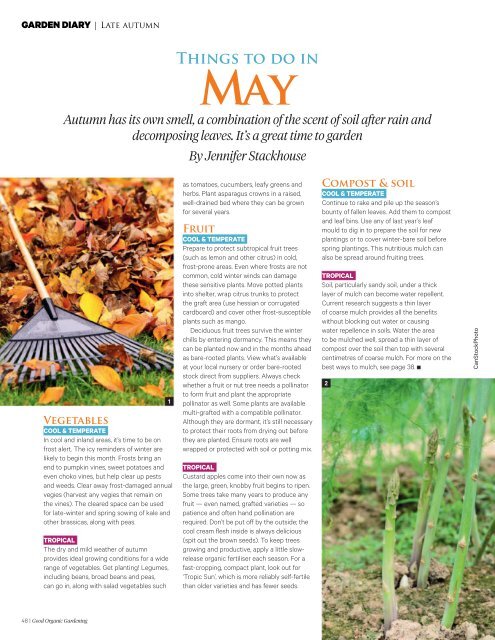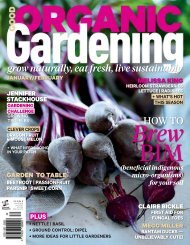3. Good Organic Gardening - May-June 2016 AvxHome.in
3. Good Organic Gardening - May-June 2016 AvxHome.in
3. Good Organic Gardening - May-June 2016 AvxHome.in
Create successful ePaper yourself
Turn your PDF publications into a flip-book with our unique Google optimized e-Paper software.
GARDEN DIARY | Late autumn<br />
Th<strong>in</strong>gs to do <strong>in</strong><br />
<strong>May</strong><br />
Autumn has its own smell, a comb<strong>in</strong>ation of the scent of soil after ra<strong>in</strong> and<br />
decompos<strong>in</strong>g leaves. It’s a great time to garden<br />
By Jennifer Stackhouse<br />
Vegetables<br />
COOL & TEMPERATE<br />
In cool and <strong>in</strong>land areas, it’s time to be on<br />
frost alert. The icy rem<strong>in</strong>ders of w<strong>in</strong>ter are<br />
likely to beg<strong>in</strong> this month. Frosts br<strong>in</strong>g an<br />
end to pumpk<strong>in</strong> v<strong>in</strong>es, sweet potatoes and<br />
even choko v<strong>in</strong>es, but help clear up pests<br />
and weeds. Clear away frost-damaged annual<br />
vegies (harvest any vegies that rema<strong>in</strong> on<br />
the v<strong>in</strong>es). The cleared space can be used<br />
for late-w<strong>in</strong>ter and spr<strong>in</strong>g sow<strong>in</strong>g of kale and<br />
other brassicas, along with peas.<br />
TROPICAL<br />
The dry and mild weather of autumn<br />
provides ideal grow<strong>in</strong>g conditions for a wide<br />
range of vegetables. Get plant<strong>in</strong>g! Legumes,<br />
<strong>in</strong>clud<strong>in</strong>g beans, broad beans and peas,<br />
can go <strong>in</strong>, along with salad vegetables such<br />
1<br />
as tomatoes, cucumbers, leafy greens and<br />
herbs. Plant asparagus crowns <strong>in</strong> a raised,<br />
well-dra<strong>in</strong>ed bed where they can be grown<br />
for several years.<br />
Fruit<br />
COOL & TEMPERATE<br />
Prepare to protect subtropical fruit trees<br />
(such as lemon and other citrus) <strong>in</strong> cold,<br />
frost-prone areas. Even where frosts are not<br />
common, cold w<strong>in</strong>ter w<strong>in</strong>ds can damage<br />
these sensitive plants. Move potted plants<br />
<strong>in</strong>to shelter, wrap citrus trunks to protect<br />
the graft area (use hessian or corrugated<br />
cardboard) and cover other frost-susceptible<br />
plants such as mango.<br />
Deciduous fruit trees survive the w<strong>in</strong>ter<br />
chills by enter<strong>in</strong>g dormancy. This means they<br />
can be planted now and <strong>in</strong> the months ahead<br />
as bare-rooted plants. View what’s available<br />
at your local nursery or order bare-rooted<br />
stock direct from suppliers. Always check<br />
whether a fruit or nut tree needs a poll<strong>in</strong>ator<br />
to form fruit and plant the appropriate<br />
poll<strong>in</strong>ator as well. Some plants are available<br />
multi-grafted with a compatible poll<strong>in</strong>ator.<br />
Although they are dormant, it’s still necessary<br />
to protect their roots from dry<strong>in</strong>g out before<br />
they are planted. Ensure roots are well<br />
wrapped or protected with soil or pott<strong>in</strong>g mix.<br />
TROPICAL<br />
Custard apples come <strong>in</strong>to their own now as<br />
the large, green, knobby fruit beg<strong>in</strong>s to ripen.<br />
Some trees take many years to produce any<br />
fruit — even named, grafted varieties — so<br />
patience and often hand poll<strong>in</strong>ation are<br />
required. Don’t be put off by the outside; the<br />
cool cream flesh <strong>in</strong>side is always delicious<br />
(spit out the brown seeds). To keep trees<br />
grow<strong>in</strong>g and productive, apply a little slowrelease<br />
organic fertiliser each season. For a<br />
fast-cropp<strong>in</strong>g, compact plant, look out for<br />
‘Tropic Sun’, which is more reliably self-fertile<br />
than older varieties and has fewer seeds.<br />
Compost & soil<br />
COOL & TEMPERATE<br />
Cont<strong>in</strong>ue to rake and pile up the season’s<br />
bounty of fallen leaves. Add them to compost<br />
and leaf b<strong>in</strong>s. Use any of last year’s leaf<br />
mould to dig <strong>in</strong> to prepare the soil for new<br />
plant<strong>in</strong>gs or to cover w<strong>in</strong>ter-bare soil before<br />
spr<strong>in</strong>g plant<strong>in</strong>gs. This nutritious mulch can<br />
also be spread around fruit<strong>in</strong>g trees.<br />
TROPICAL<br />
Soil, particularly sandy soil, under a thick<br />
layer of mulch can become water repellent.<br />
Current research suggests a th<strong>in</strong> layer<br />
of coarse mulch provides all the benefits<br />
without block<strong>in</strong>g out water or caus<strong>in</strong>g<br />
water repellence <strong>in</strong> soils . Water the area<br />
to be mulched well, spread a th<strong>in</strong> layer of<br />
compost over the soil then top with several<br />
centimetres of coarse mulch. For more on the<br />
best ways to mulch, see page 38.<br />
2<br />
CanStockPhoto<br />
48 | <strong>Good</strong> <strong>Organic</strong> <strong>Garden<strong>in</strong>g</strong>
















